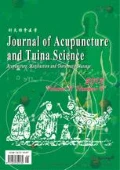摘要
目的
观察捏脊加穴位贴敷治疗脾虚型小儿脑瘫的临床疗效。
方法
将70 例脾虚型脑瘫患儿随机分为治疗组和对照组, 治疗组在采用综合康复疗法的基础上加用捏脊及穴位敷贴, 对照组仅采用综合康复疗法。 每天治疗1 次, 20 d 为1 个疗程, 共观察3 个疗程。
结果
治疗组临床症状总有效率77.1%, 对照组为39.9%; 治疗组康复疗效总有效率为74.3%, 对照组为48.6%。 治疗组有效率均明显优于对照组, 具有统计学意义(P<0.05)。
结论
捏脊加穴位敷贴治疗脾虚型脑瘫患儿的效果明显, 值得临床推广应用。
Abstract
Objective
To observe the clinical effect of pinching spine plus acupoint sticking therapy for infantile cerebral palsy (ICP) with spleen deficiency pattern.
Methods
Seventy children of ICP with spleen deficiency pattern were randomly divided into a treatment group and a control group. Those in the treatment group were given the comprehensive rehabilitation therapy plus pinching spine and acupoint sticking therapy. Those in the control group were just given the comprehensive rehabilitation therapy. The treatment was given once every day, 20-day as one course, and totally for three courses.
Results
The total effective rate of the clinical symptoms was 77.1% in the treatment group and 39.9% in the control groups. The total effective rate of rehabilitation effects was 74.3% in the treatment group and 48.6% in the control group. The effective rate was obviously better in the treatment group than that in the control group, with statistical differences (P<0.05).
Conclusion
Pinching spine plus acupoint sticking therapy is remarkable in the therapeutic effects for ICP with spleen deficiency pattern, and needs to be popularized clinically.
References
Hu YY. Historical evolution of cerebral palsy definition. Zhongguo Kangfu Lilun Yu Shijian, 2003, 9 (15): 257–258.
Editorial Board of Chinese Journal of Pediatrics, the Subspecialty Group of Neurology, Pediatric Society, Chinese Medical Association. Definition, diagnostic criteria and clinical types of cerebral palsy in children. Zhonghua Erke Zazhi, 2005, 43(4): 262.
Pediatric Commission of Chinese Association of Integrated Chinese and Western Medicine. Diagnostic criteria of infantile spleen deficiency pattern: a draft. Zhongguo Zhongxiyi Jihe Zazhi, 2000, 20(2):172–174.
Wang LQ, Ge JL. The clinical observation of chiropractic therapy on exogenous fever of pediatrics. Henan Zhongyi Xueyuan Xuebao, 2006, 21(5): 47.
Liu ZH, Pan FG, Ma MM, Qian XG, Fu WJ, Zhang HY, Zhang CT. Observation of life quality of sick children in acupuncture treatment of spastic cerebral palsy. Zhongguo Zhongxiyi Jiehe Zazhi, 2007, 27 (3): 214–216.
Wu XB, Zhang HM, Sun KX. Assessment of the effect of interactive scalp acupuncture on gross motor function in treating infantile spastic cerebral palsy. Shanghai Zhenjiu Zazhi, 2011, 30 (3): 177–179.
Qin XD. TANG’s scalp acupuncture and infantile cerebral palsy: case reports of 34 cases. J Acupunct Tuina Sci, 2008, 6(6): 373–375.
Cao WS, Hu M, Tan LM. Influence of acupuncture combined rehabilitation on long-term prognosis in perinatal brain injury. Shanghai Zhenjiu Zazhi, 2009, 28(3): 146–148.
Liu ZH, Qi YC, Pan PG, Ma MM, Qian XG, Fu Wj, Zhang HY. Clinical observation on effect of clearing the Governor Vessel and refreshing the mind needling on head SPECT and CT scanning of kid with cerebral palsy. J Acupunct Tuina Sci, 2007, 5(4): 209–212.
Wang J, Sun KX, Wu XB, Zhang NX, Zhu HJ. Preliminary study of the effect of scalp acupuncture on motor function in infantile cerebral palsy. Shanghai Zhenjiu Zazhi, 2009, 28(11): 634–636.
Hong J, Huang QF. Exploration of the clinical regularity of acupuncture and moxibustion treatment for cerebral palsy syndrome. J Acupunct Tuina Sci, 2010, 8(5): 272–276.
Ma MM, Liu ZH, Zhao Y, Luo GJ, Li N, Zhao WJ, Wan RP. Clinical observation on treatment of spastic cerebral palsy with tuina plus music therapy. J Acupunct Tuina Sci, 2009, 7(4): 213–217.
Guo JX, Zhao Y. On value of adult chiropractic therapy. Anmo Yu Daoyin, 1999, 15 (4): 2.
Zhang R, Wang LQ, Yang J, Wang GC. Clinical observation of chiropractic therapy for spleen-energy deficiency syndrome in children. Qilu Yixue Zazhi, 2003, 18(2): 166–167.
Song WJ, Huang L, Li ZP. Treatment of 128 cases of lienteric diarrhea by acupuncture and spine pinching. J Acupunct Tuina Sci, 2009, 7(4): 231–232.
Hong C. Research progress of acupoint sticking therapy for infantile diarrhea. Neimenggu Zhongyiyao, 2011, (23): 108–109.
Zhang LP, Zhang HJ, Wang CY. Acupoint transdermal absorptive agent: research and manufacture of polyurethane topical agent of Naoshuantong. Heilongjiang Zhongyiyao, 1996, 16(6): 46.
Author information
Authors and Affiliations
Corresponding author
Rights and permissions
About this article
Cite this article
Xie, Js., Chen, Hb., Li, Yx. et al. Observation on therapeutic effects of pinching spine plus acupoint sticking therapy for infantile cerebral palsy with spleen deficiency pattern. J. Acupunct. Tuina. Sci. 10, 305–309 (2012). https://doi.org/10.1007/s11726-012-0625-6
Received:
Published:
Issue Date:
DOI: https://doi.org/10.1007/s11726-012-0625-6

